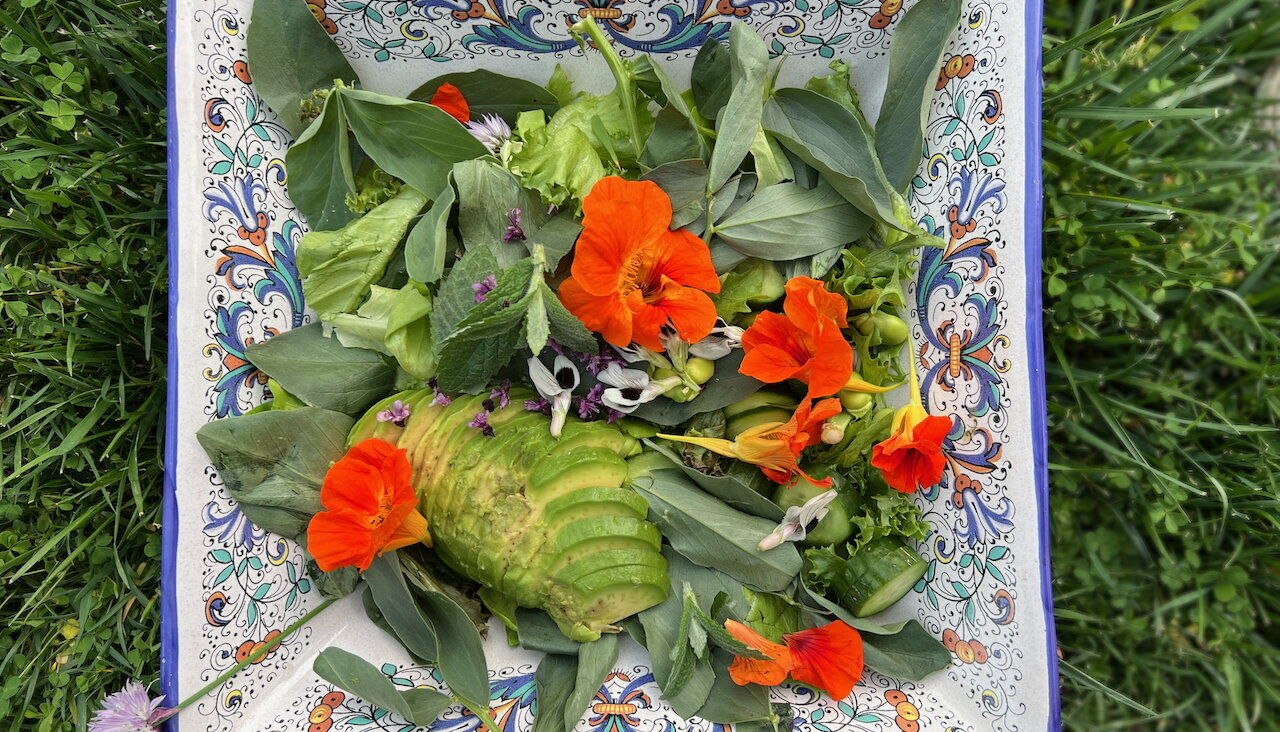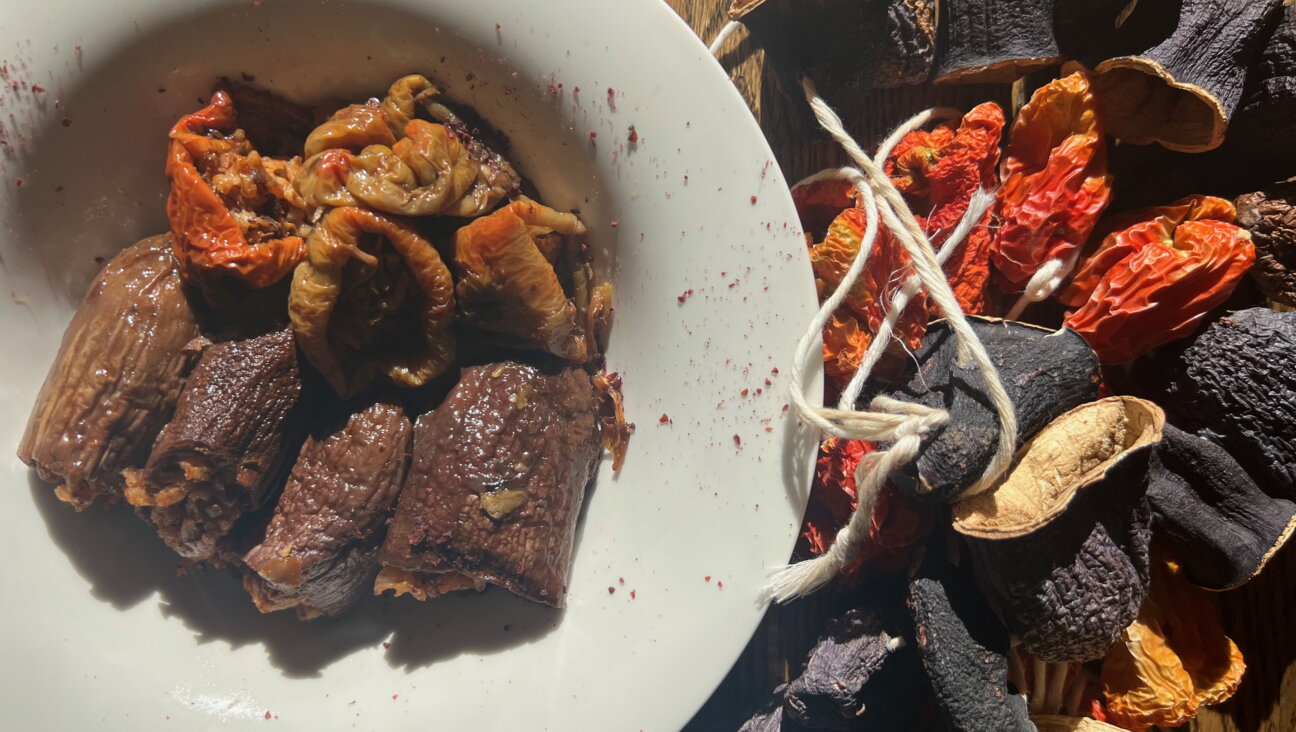Sandwiches of Israel: The Divine Sabich

Falafel and shwarma are so ubiquitous in Israel and in the American Jewish cuisine that it would be easy to think that there are no other iconic sandwiches of Israel. For those who think this – I am supremely sorry that up to this point, you have been deprived of sabich.

A sandwich made in pita or laffa (a baked flat bread), stuffed with fried eggplant, hummus, salads, a hard boiled or baked egg and topped with tahina and amba (a tangy bright orange condiment made from pickled mango) – sabich is a intriguing and delicious blend of textures and flavors with bites alternating between the tang of amba and the sweetness of silken fried eggplant, with the crunch of fresh Israeli salads thrown in.
The sabich at Taim, a popular Israeli take out place in New York city, that purportedly brought the sandwich to the city, was recently featured on the Village Voice’s food blog, Fork in the Road’s 100 Dishes to Eat Now list, “ a handy list of some of our favorite dishes – old standbys and new finds alike – compiled daily.”
Chef-owner of Taim Einat Admony says: “Today every falafel place [in Israel] has sabich as well. There are also some small places that do just sabich and do it very well.”
Sabich has its roots in Israel’s Iraqi community, which historically prepared and enjoyed the sandwich for shabbat breakfast, with a long-cooked baked brown egg instead of the white boiled egg it is often served with now. While most of Israel’s Iraqi community immigrated before the creation of the state in the early 1950s, it wasn’t until the 1970s that – as legend has it – two sandwich shops opened in Ramat Gan and Giv’atayim, in the suburbs of Tel Aviv, that the sandwich was introduced to the broader Israeli community. Though it took a while to catch on says Admony: “There was two places… in the late 70s, but it wasn’t common like today.”
The origins of its name are even blurrier. Supposedly the dish from Iraq did not have a specific name and according to Adeena Sussman at My Jewish Learning the name came from “The root letters of sabich S-B-H– [which] spell ‘morning’ in Arabic,” when the sandwich was originally consumed “however, some believe the letters stand for salat, beizah, hazilim (salad, eggs, eggplant) – the sandwich’s main ingredients” she continues.
Though Admony and others say it was named for the owner of one of the original sabich shops near where she grew up. “A guy that game from Iraq – it was his name he had his own his Sabich shop – is the story I’ve always heard,” says Admony.
While never one to overlook history, some of the best stories and foods are left to legend. Sabich, with its unusual blend of Iraqi and Israeli flavors, mysterious name and unclear past is the perfect example of that.
Sabich at Home:
1 Pita
2-3 slices fried eggplant
Hummus
Israeli salad or cabbage salad (tomatoes, cucumber, olive oil, salt, pepper, lemon juice and parsley or essentially coleslaw, minus the carrots)
1 hard boiled egg, sliced
Abma
Tahina
1) Cut the pita partially open like a pocket – the same way falafel is served
2) Place a liberal tablespoon or two of hummus in the pita
3) Add one slice of fried eggplant
4) Then add the salad(s)
5) Add the remaining eggplant slice(s)
6) Place the sliced egg into the pita (it should be almost full if not brimming now)
7) Top with tahina and amba
The Forward is free to read, but it isn’t free to produce

I hope you appreciated this article. Before you go, I’d like to ask you to please support the Forward.
Now more than ever, American Jews need independent news they can trust, with reporting driven by truth, not ideology. We serve you, not any ideological agenda.
At a time when other newsrooms are closing or cutting back, the Forward has removed its paywall and invested additional resources to report on the ground from Israel and around the U.S. on the impact of the war, rising antisemitism and polarized discourse.
This is a great time to support independent Jewish journalism you rely on. Make a gift today!
— Rachel Fishman Feddersen, Publisher and CEO
Support our mission to tell the Jewish story fully and fairly.
Most Popular
- 1

Culture Cardinals are Catholic, not Jewish — so why do they all wear yarmulkes?
- 2

Fast Forward Ye debuts ‘Heil Hitler’ music video that includes a sample of a Hitler speech
- 3

News School Israel trip turns ‘terrifying’ for LA students attacked by Israeli teens
- 4

Fast Forward Student suspended for ‘F— the Jews’ video defends himself on antisemitic podcast
In Case You Missed It
-

Opinion This week proved it: Trump’s approach to antisemitism at Columbia is horribly ineffective
-

Yiddish קאָנצערט לכּבֿוד דעם ייִדישן שרײַבער און רעדאַקטאָר באָריס סאַנדלערConcert honoring Yiddish writer and editor Boris Sandler
דער בעל־שׂימחה האָט יאָרן לאַנג געדינט ווי דער רעדאַקטאָר פֿונעם ייִדישן פֿאָרווערטס.
-

Fast Forward Trump’s new pick for surgeon general blames the Nazis for pesticides on our food
-

Fast Forward Jewish feud over Trump escalates with open letter in The New York Times
-
Shop the Forward Store
100% of profits support our journalism
Republish This Story
Please read before republishing
We’re happy to make this story available to republish for free, unless it originated with JTA, Haaretz or another publication (as indicated on the article) and as long as you follow our guidelines.
You must comply with the following:
- Credit the Forward
- Retain our pixel
- Preserve our canonical link in Google search
- Add a noindex tag in Google search
See our full guidelines for more information, and this guide for detail about canonical URLs.
To republish, copy the HTML by clicking on the yellow button to the right; it includes our tracking pixel, all paragraph styles and hyperlinks, the author byline and credit to the Forward. It does not include images; to avoid copyright violations, you must add them manually, following our guidelines. Please email us at [email protected], subject line “republish,” with any questions or to let us know what stories you’re picking up.















